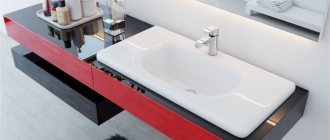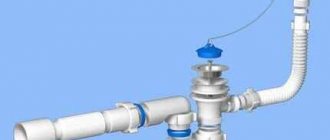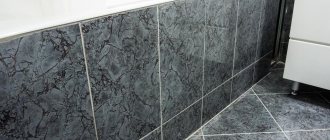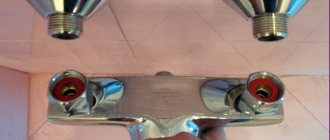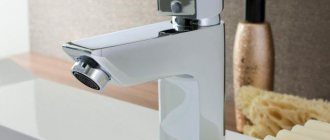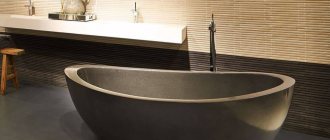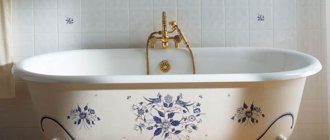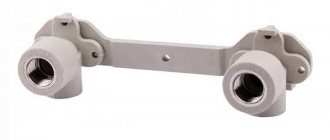Standards according to SNiP
Building codes and regulations (SNiP) are based on statistical research, testing theoretical calculations in practice - that is, the ease of use of plumbing fixtures in the bathrooms of apartments and public institutions. At the same time, collections of rules standardize the basic requirements for the design of certain building structures.
According to SNiP 3.05.01-85, the installation height of a sink in a bathroom (regardless of whether it is a private bathroom or a public one) is 800...850 mm from the floor, the permissible deviation is +/-20 mm. For schools, kindergartens, hospitals and clinics, places of visit for the disabled or people with temporarily limited mobility, the parameter may vary. Data on other plumbing fixtures are presented in the table.
Important: when installing a joint mixer for a sink and bathtub, its position is determined by a higher-lying plumbing fixture, usually the sink. Thus, the height of the sink in the bathroom from the floor (standard) along the top of the side and the installation height of the faucet in the bathroom (along the bottom edge of the body) are the same.
The RF standard is focused on devices installed by builders during mass construction. Thus, the installation height of the bathtub from the floor in the table is given for a typical cast iron or steel product with legs. For acrylic, modern cast iron and steel bathtubs, glass models, the position is determined individually, in accordance with the geometry of the model and the method of its installation. If the product is installed on a podium, the distance from the finished floor to the top of the side is calculated from the top plane of the podium. Thus, the height of an acrylic bathtub is determined by the height of the podium, the type of supports and linings under the bowl.
In addition to the height of the bathtub from the floor (standard) and the position of the sink side, the required free area in front of the plumbing fixtures and the distance between them are standardized.
It is important to understand: the standards for the placement of plumbing fixtures are justified, but are not indisputable. If there are no other options, you can change the relative position of the devices so as to provide users (taking into account their physical characteristics) a comfortable stay in the bathroom.
Regulatory Requirements
Regulatory requirements for the installation of pipeline fittings in accordance with SNiP 2.04.01 clause 10.5 are given in table No. 2.
Table 2. Regulatory requirements for the installation of pipeline fittings for cold and hot water supply
|
|
|
|
|
|
|
|
|
|
|
|
|
| ||
|
| ||
|
| ||
|
| ||
|
| ||
|
| ||
|
| ||
|
| ||
|
|
| |
|
|
| |
|
|
| |
|
|
| |
|
|
| |
|
|
|
|
|
|
| |
|
|
| |
|
|
|
|
|
|
|
|
|
|
|
|
|
| ||
|
| ||
|
| ||
|
| ||
|
|
|
|
|
| ||
|
| ||
|
|
When purchasing plumbing fixtures, the presence of invisible cracks is determined by ear by tapping the product, located on a wooden stand, with a wooden hammer weighing about 250 g. A product that has cracks makes a rattling sound when tapped.
The presence of nicks and scratches is determined visually by wiping the surface of the product with a cloth soaked in a 0.1% solution of methylene blue solution. If there are nicks or scratches, they are filled with a blue solution and are detected visually without the use of magnifying devices.
Combination of devices
If it is necessary to install the sink so that its edge is partially above the edge of the bathtub or shower tray, an “overlay” up to the full width of one of the edges is acceptable. For the “tulip” model (with a pedestal), the height of the sink from the floor is determined by the pedestal, as well as the possibility of moving the bowl towards the bathtub. For semi-pedestals, the parameters are more variable.
If space is particularly tight and a larger offset is needed, it is possible to position the sink almost entirely over the narrow end of a shaped bathtub. In this case, it is imperative to ensure a convenient approach to the washbasin and the possibility of its full use.
The height of the washbasin in the bathroom from the floor in such options is determined by the position of the side of the bathtub and the length, as well as the shape and location of the siphon. In such combined installations, special models with reduced working elements are usually used. Washbasins with an asymmetrical arrangement of the drain hole and, accordingly, the siphon are also popular.
Another interesting way to save space is to place the sink above the washing machine. In such cases, machines with a reduced height (600...700 mm instead of the standard 800...850 mm) and special sinks are installed. In them, the drain is moved to one of the corners or closer to the back wall so that it does not interfere with the installation of the washing machine. With proper selection and installation, plumbing fixtures do not suffer from vibration during the process of rinsing or spinning clothes.
The question of what height to hang a sink in the bathroom is determined by the height of the washing machine and the size of the gap between its upper plane and the bottom of the washbasin, as well as the position of the drain and siphon.
Another combination option for small bathrooms is a washbasin located above the toilet cistern. There are two possible combinations here - either a sink that partially hangs over the tank, or a model where the bowl is built into the tank. In this case, additional water savings are possible. The liquid used during hygiene procedures is drained into the tank and then goes to be flushed in the toilet.
The standard height of the sink from the floor in the bathroom can be maintained or changed, it all depends on the layout of the devices and the location of the free space nearby.
Other combinations of equipment can further save space and reduce water consumption, for example, installing a washing machine above the toilet. Often it is mounted in a niche or on a specially organized ledge, but “advanced manufacturers” also offer kits with a special fastening system.
How to correctly calculate the installation height
Practical experience does not contradict the standards and instructions for assembling faucets - the mechanism is installed at a distance of 20 cm from the tank. But the practice is not strict regarding the location of the tap - you can install it at a suitable point, at a convenient distance from the bath or shower, you just need to follow the main points when installing:
- before installing the device, measure it according to its elevation and evaluate the convenience of the position of the tap;
- if we are talking about a shower, then the device is installed at a height of 120 cm from the shower. The presented figure must be measured from the bottom of the container;
- A frequent mistake in calculating at what distance the device should be installed above the container from the floor appears because the height of the bowl is taken as the reference point even before installation. This is wrong - because sometimes you need to provide a bathtub with great durability by installing special stands. It may turn out that the calculated installation height of the structure above the bathtub of 20 cm at the end of the work will turn out to be 10 cm, the faucet will hang above the capacity, and will not only look ugly, but will be very inconvenient to use. Moreover, not all types of cranes can be placed at such a small distance;
- installing the structure from the end of the container is a parameter that must be measured and calculated first. This is especially necessary when the tap is supposed to be turned from the bathroom to the sink and vice versa. Remember about the size of the sink - it is usually more than 850 cm. And to this parameter you need to add the size of the mechanism itself, as well as the distance between the gander and the sink - here it is better to make an error on the positive side than on the negative side;
- The installation indications are also influenced by additional parts that are often supplied with current faucets - for example, water softeners, as well as the desires of those who will use the bathroom, many who want the faucet to be installed above the container at a high elevation - so they can wash their hair, without the need to take a shower or draw large amounts of water;
When installing the mechanism on the wall, you must try to avoid attaching the structure to the tile, to its edges - a rigid application of material will not allow the faucet reflectors to be firmly fixed. Therefore, the height of the installation of the crane can be firmly connected with the height of the curb (it is usually laid at a height of a meter from the floor).
Mixers common and separate
The faucet for delivering water to the sink, bathtub or shower can be separate for each device or used for two or three at the same time. The most common type is a wall-mounted faucet with a swivel spout and shower head, which is mounted above the bathtub or sink (or between them) and serves both containers.
The height of the mixer above the bathtub is determined by the convenience of adjusting the water when using both plumbing fixtures, and the accessibility of the adjustment lever or valves for a person lying in the bathtub.
The above diagram takes into account the standard height of the bathtub; when lifting it onto a podium, embedding it in a bed, or using another installation system, the parameters change.
Important: a mixer with a thermostat and automatic water temperature control can be installed higher than usual.
In shower compartments and stalls, faucets are usually installed so that other plumbing fixtures are not served by them. At the same time, a distinction is made between devices with a standing (mostly) and a sitting (much less often) user position. Taking into account the production of shower boxes and cabins of standard sizes, it is important to take into account their dimensions when choosing the position of the mixer.
There are no such standards for compartments; here the size of the room depends only on the layout of the rooms allocated for hygienic procedures and the intended design. However, on average, the height of the mixer in the shower from the tray (bottom) is 800...1000 mm. This refers to the position of the housing with the adjusting elements.
To select the correct position, take into account the composition of the users and their dimensions, as well as the usual postures while taking a shower. If a seat is provided in the shower stall (compartment), the mixer body is mounted taking into account convenient access to it for a seated user.
If a bathtub is used as a shower tray, when calculating the distance, the height of the bathtub from the floor with legs (standard) and the distance from the finished floor to the bottom of the bathtub are taken into account.
Layout of inspection windows for servicing Riho Jacuzzi bathtubs (Holland)
a - Hydropool systems; b — Aeropool systems
Connecting a jacuzzi to an electrical network is a rather responsible and complex process. It should only be performed by a qualified electrician (at least 4th category). Despite the low power consumption, the Jacuzzi system is connected with a separate hidden waterproofed cable with a cross-section of 3x2.5 mm. The power supply (circuit breaker or socket) should be outside the bathroom, and the distribution panel should be located close to the bathroom, but preferably behind a partition. The switchboard contains the main switch, circuit breaker and 30 A fuse. The motor is protected by a double casing and does not require additional protection.
In addition to the bath itself, the standard set of a hydromassage bathtub-jacuzzi includes an installation frame, an automatic siphon, and a massage system. A Jacuzzi bathtub can be equipped with additional micro-nozzles, including rotating ones, halogen lighting, and a system for maintaining water temperature.
Installation of deep shower trays is done in the same way as bathtubs. Conventional shower trays are mounted on the floor of the room and connected to the sewer network through a water seal. Shower trays, like bathtubs, must be equipped with potential equalizers.
Installation of sinks (figure below) is usually carried out on a sub-table 6 made of wood, plastic and other materials. After installing the mixer 2 with connections, the sink is placed on the underframe (Figure below, a), water supply connections 4 are connected (Figure below, b), outlet 3 is installed, water seal 7 is connected to sewer connections 5 (Figure below, c ). After installing the sink, check its installation position (figure below, d, e). Installation of sinks mounted on brackets is carried out in the same sequence as the installation of sinks. In sinks located in public canteens, kitchens, grocery stores, there should be an air gap of 20-30 mm between the outlet and the water seal.
Position of floor and table mixer
Unlike wall-mounted faucets, whose placement is strictly standardized in accordance with the requirements of ergonomics and ease of installation, the height of a floor-standing faucet is determined only by its design.
Typical models are designed for certain models of bathtubs or washbasins (usually also floor-mounted), and are mounted on the floor or on a small elevation.
In general, the height of the bathroom faucet from the floor (standard) corresponds to the usual position of the wall-mounted model; for very high bathtubs, an additional step is used.
For built-in sinks and washbasins, the position of the faucet is determined solely by the height of the countertop or sink rim. Therefore, the standard height of the sink from the floor in the bathroom and the height of the countertop in the bathroom are usually the same.
Important: if the height of the bathroom vanity cabinet does not meet the standards, it can be mounted using a hanging method or installed on a podium. In this case, the difference between the ergonomically adjusted position and the actual height is leveled out.
Hidden fastening system
This method is intended for attaching wall-mounted urinals to a metal frame, which greatly simplifies the maintenance of the attached communications and sewerage, for the full functioning of the entire system.
This installation requires the additional installation of a metal frame to which sewerage and communications are connected. After which the metal frame is covered with plasterboard for subsequent decorative finishing, and then the bowl itself is attached to the frame.
Accessories and useful little things
In addition to the location of plumbing fixtures, it is also important to correctly place accessories - a mirror, holders for towels and toothbrushes, shelves and stands. Determining at what height to hang a mirror in the bathroom should depend on the height and habits of the users. A good option may be a stationary mirror panel mounted on the wall and an additional mirror on a telescopic or sliding tripod with the ability to rotate. Backlighting is also desirable.
With such a tripod, the height of the mirror in the bathroom is not decisive and can be selected depending on the convenience of the layout.
Other details that facilitate the use of bathrooms are located so that the visitor can easily reach any of the items, but at the same time they do not interfere with free movement and do not clutter the bathroom.
Important: when arranging a bathroom in a house where there are disabled people or people with limited mobility, or small children, it is necessary to either move the accessories lower to a level accessible to them, or add elements.
Grab bars and holders near bathtubs, shower stalls, and toilets are not considered mandatory if all users are healthy and adults without problems with excess weight. They are added only in cases where there is a risk of injury due to slippery coatings (although it is better to replace the coatings themselves) and for certain mobility problems among bathroom users.
The position of the handrails and their type, as well as the method of fastening, are standardized in accordance with the nature of the users’ problems and are the same only for public bathrooms, where all auxiliary parts are fastened according to an average scheme.
For an individual bathroom, it is better to calculate the dimensions taking into account the characteristics of the users.
By the way: handrails and non-slip mats are useful not only for disabled people. Overweight people, pregnant women, children - they would all benefit from additional support and protection from accidental damage.
Notations
- ↑ 12Jaggard.
The Flow of History: The Mercifully Dwindling Presence of the Parisian Pissoir(undefined)
(unavailable link).
Paris Update
(March 27, 2012). Retrieved July 18, 2021. Archived July 20, 2021.
- Fierro, 1996, p. 1177.
- Pike, 2005, p. 234.
- Bagamery
. 'Wild peeing' on the nose as authorities crack down in Paris,ABC News (Australia)
, Australian Broadcasting Corporation (10 June 2018). Retrieved June 10, 2021.
- Ross, 2006.
- Bärthel, Hilmar (2000): "Tempel aus Gusseisen: Urinale, Café Achteck und Vollanstalten", Berlinische Monatsschrift Heft 11
- Café Achteck - Berlin's Green Pissoir. Berlin Love
(13 November 2017). Retrieved November 2, 2021. - Wiens letzte Öl-Klos werden saniert (German). wien.orf.at
(14. November 2017). Retrieved November 2, 2021. - Wiener Pavillon Pissoir, 1908 – Technisches Museum Wien (undefined)
.www.technischesmuseum.at
. Retrieved November 2, 2021.
- street urine (undefined)
.HERITAGE GROUP WEBSITE for the CHARTERED INSTITUTION of BUILDING SERVICES ENGINEERS
. Retrieved November 2, 2021.
- Cast Iron Street Urinals - Group (undefined)
.Victorian Heritage Database.
.
- "The Pee Pod - the place to pee in Milton Keynes!" BBC News
, 15 June 2010. - "Edinburgh to trial 'pee pod' street urines." BBC News
, 24 November 2010.
conclusions
Calculating the position of plumbing fixtures and auxiliary equipment, furniture and accessories in the bathroom does not necessarily have to rely entirely on statistical data and SNiP. To check whether the standard height of a bathtub from the floor with legs or the height of the faucet above the bathtub is suitable for a particular family, it is worth “estimating for yourself” the ergonomic parameters of the room and choosing the optimal placement option.
To check standard sizes, help is needed - with a tape measure or a long ruler, an assistant determines the difference between standard and individual data and selects a specific value from the proposed ranges.
How to hang a urinal yourself
After the holes on the wall are marked, we proceed to drilling them. Now plugs are installed in the prepared holes. The anchors will be screwed into them.
Despite the fact that the total weight of the urinal is quite small, professionals still recommend using anchors for installation. Firstly, it is more reliable. Secondly, it is much simpler and takes less time.
The urinal is attached to the anchors using a plastic washer, a metal washer and an ordinary nut. Excessive tightening does not make any sense.
In any case, the nut will not unscrew, which will ensure reliable fixation of the plumbing equipment on the wall.
The video very clearly demonstrates the technique for installing a modern urinal on a prepared wall surface:
Automatic drain
This method has proven itself well in the arrangement of modern houses and luxury establishments, as well as in the arrangement of private houses. The urinal is touch sensitive, eliminating the need to press the flush button, thereby making this process more comfortable and very modern.
Thanks to the sensors installed on the urinal, water is drained after the laser beam returns to its original position, which was refracted at the time of use.
In popular culture
The urinal was featured in the opening scene of the 1967 James Bond film Casino Royale
. [1]
The urinal was also featured in several episodes of the British World War II-era comedy series, Allo, Allo!
, it hosted a meeting between Rene Artois (Nighthawk) and other members of the Resistance; it was accidentally blown up several times, twice while Officer Crabtree was inside and once with Italian Captain Alberto Bertorelli.
In the second season of Two and a Half Men
Episode 22 of Season 2, “That Old Whore Is My Mother,” Alan’s mother invites him to dinner at Le Pissoir restaurant.
Bibliography
- Fierro, Alfred.
Histoire et dictionnaire de Paris. - Robert Laffont (English) Russian, 1996. - ISBN 2-221-07862-4. - Pike, David L.
Subterranean Cities: The World Beneath Paris and London, 1800-1945 (English). - Cornell University Press (English) Russian, 2005. - ISBN 978-0-801-47256-5. - Ross, Paul.
The Vanashing Vespasienne // Shaggy Dog Tales: 58 1/2 Years of Reportage (English). - Xlibris (English) Russian, 2006. - P. 49-51. — ISBN 978-1-450-09805-2.
Advantages of shower stands
Shower stands are universal plumbing equipment that can function perfectly in both a conventional bathtub and various types of shower stalls. Such devices are designed to secure the shower head so that they are comfortable to use. Such equipment is inexpensive and can really reduce the budget allocated for transforming a bathroom. Having excellent performance qualities, it is endowed with the following advantages:
- ease of use;
- versatility;
- simple installation.
What is taken into account when choosing?
Modern manufacturers of sanitary equipment offer a wide selection of urinals to suit every taste and budget. When choosing the optimal model, you should take into account some characteristics and quality indicators. Let's look at the main points.
First, you should decide on the mounting method: there are hanging models (more compact, suitable for small spaces) and floor-standing units (large in size, often installed in public places).
Secondly, urinals differ in the shape of the bowl. Modern designers offer oval, triangular, rectangular, corner models, as well as exclusive ones, for example, in the form of an open mouth of animals!
Thirdly, you should pay attention to the drainage system. There are models with mechanical (manual), semi-automatic and automatic draining. Also important is the method of water supply: external (relevant for floor structures) or hidden (for installation of communications hidden in the wall).
And fourthly, when choosing a urinal, you should take into account the weight and material of the structure. If you plan to hang the item on a wall (not a permanent one), you should give preference to the lightest materials - plastic or metal. For a different type of installation, the choice should be on models made of earthenware or porcelain. Additionally, it is worth noting that the last two materials are considered to be the most hygienic, easy to clean, the coating of which prevents the spread of unpleasant odors.
To summarize, it is worth noting that the fashion for installing urinals came to us at the end of the last century from European countries. This piece of plumbing can be found in almost all public places. However, many questions arise when installing them. Before installing a brand new urinal, you should carefully study the existing installation standards and regulations.
Personal hygiene rooms
Projects for the construction or reconstruction of educational buildings must include personal hygiene rooms intended for students of the II-III educational levels. Such premises must have a minimum area of 3.0 m² and must be divided into individual booths, each of which is designed for 70 conventional users. The list of installed equipment includes a tray with a flexible hose or bidet, a toilet and a washbasin with hot and cold water supply. In existing educational buildings, personal hygiene rooms are located in the toilets.
Design
Despite the fact that the design of urinals is unchanged, the versatility and decorativeness of this plumbing fixture can be achieved by the type of material from which it is made.
With the help of modern technologies, it is possible to make almost any shape from plastic, ceramics, glass, stone, porcelain, as well as shape ferrous and non-ferrous metals. Such a wide range of materials offered will be able to implement most design solutions.
Urinals actually have a number of advantages over a regular toilet.
Wall-mounted urinals require less space to install, are much easier to care for, and are easy to maintain.
Plus, they can significantly reduce your costs by consuming very little water during flushing. In fact, some urinals don't even require water to operate.
They're just as quick and efficient to use, which is probably one of the reasons why there tend to be shorter lines outside men's restrooms.
Of course, despite all the benefits that wall-mounted urinals provide, a huge portion of the population will never use them. Thus, the conventional toilet will occupy a leading position in washrooms around the world. But it's definitely worth understanding how a urinal can save you money and make cleaning your bathroom easier.
To help you learn more about urinals, we've put together a comprehensive buying guide that covers everything you need to know when considering the options available on the market.
It doesn't matter if you're buying a urinal for a commercial business or adding one to your bathroom, our guide will help you better understand the features so you can make an informed decision.
Urinal in different countries
Islamic toilet etiquette prohibits urinating while standing; people must squat or sit, which is why urinals are not used in Muslim countries.
Outdoor urinal, Holland
In some European countries (France, the Netherlands, etc.), urinals are placed openly on the streets.
Types of urinals
Before purchasing a urinal, the main thing to do is to choose the type of device that is best suited for use. Unlike toilets and bidets, urinals come in only a few varieties. To narrow down your choices, let's take a closer look at the two main options.
Urinals with flush system
The most common option is traditional urinals. They work like a standard toilet. You do your thing, and once you're done, you need to wash it off. During the draining process, water flows out and helps remove all the “liquid waste” from the bowl into the drain hole.
Due to the fact that this type of urinal is quite common, you will have quite a wide range of options to choose from. There will be a variety of urinal designs, styles, finishes and features to choose from. (Yes, urinals have their own characteristics).
The most amazing thing about a water-flushing urinal is that you won't have to repair it as often as a similar waterless unit. Although, make no mistake, they still need to be cleaned and disinfected regularly.
For most users, especially if the urinal will be used in a commercial setting, this will be the most popular device. Not only because there are many options to choose from, but also because men get a familiar feeling when using these urinals.
Let's summarize:
- this is the most common type of urinal;
- there are many options available to choose from;
- requires less attention in terms of disinfection and maintenance;
- Over time, the amount of water consumed per flush may increase.
Waterless biourinals
The waterless urinal is definitely something new. They probably pique your interest because the curious have a question: how do they remove urine without water? Let's just say it's all about the unique design.
Instead of pouring water into a bowl, a biourinal is designed to use gravity to remove all liquid waste. Like a traditional urinal or toilet, they connect to your plumbing system and don't require anything else from you.
They are becoming increasingly popular, especially for large companies and stadiums, because they can dramatically reduce the amount of water used. Not only will this save you a lot of money, but it will also be good for the environment. A win-win for everyone.
The main disadvantage of a waterless urinal is that they will have to be cleaned more often than other types of urinals and may also require regular maintenance. But for many entrepreneurs, the savings and environmental benefits are worth it.

